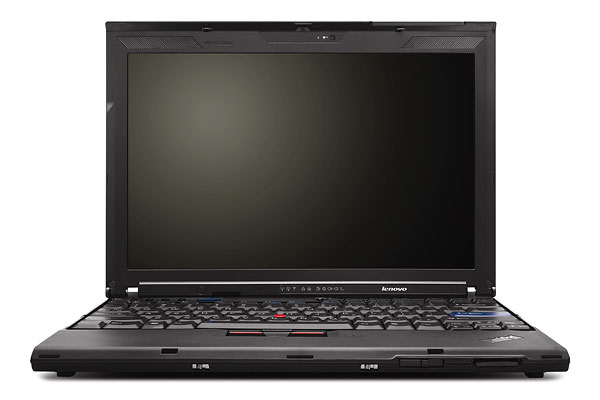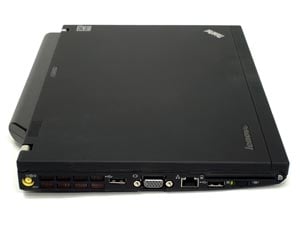Lenovo ThinkPad X200 Ultraportable Notebook
Design & Build Quality

The X200 is unmistakably a ThinkPad notebook. From the flat black paint and utilitarian design to the angled logo on the right palm rest, the X200 couldn't be anything else. While we wouldn't say they are necessarily "pretty", ThinkPads are certainly iconic and distinguished.
At first glance, the X200 looks like a miniaturized version of a ThinkPad, shrunken to 3/4 the size of its 15.4" stablemates. This is true in many respects. Despite its smaller size, the X200 shares most of the same special features as the rest of ThinkPad product line. Features like a semi-rugged design, shock-mounted hard drive, fingerprint reader with full-disk encryption, spill-resistant keyboard with drainage channels and full-sized keys, are all standard equipment.
While it may be tempting to think of the X200 as a 12.1" version of the 13.3" X300, it is in fact a direct descendent of the X61. This is both clearly evident in the X200's design and its specifications. The X300 tries to be as compact and feature-rich as possible, sacrificing raw computing power to present a fully featured notebook in an amazingly compact frame. The X200, just like the X61 before it, takes the opposite approach, sacrificing some size and features to preserve computing power.
Despite being thicker than the X300, the X200 doesn't offer a built-in optical drive. Nor does it have a touchpad, instead relying exclusively on Trackpoint navigation. The X200 makes up for these deficiencies with a full-power Intel Penryn Core 2 Duo processor running at up to 2.4GHz with a 1066MHz front-side bus frequency. That is a significant improvement over the X300's special one-off ultra low voltage SL7100 processor, which only operates at 1.2GHz with a 800MHz FSB. Lastly, these trade-offs make the X200 a lot cheaper than the decidedly premium X300.

Comparison of X-series Notebooks
The X200 will be replacing the X61 and the two notebooks have more in common than the vastly different model numbers may suggest. The X200 is in essence an updated X61. The most prominent new features are an upgraded chipset and the use of a widescreen LCD. While the X61 used a standard 4:3 aspect ratio LCD, the X200 is equipped with a 16:10 widescreen. This makes the X200 an inch wider than the X61, but the rest of its dimensions remain largely unchanged. the X200 receives an upgrade to the Centrino 2 platform which should offer better overall performance and battery life than the Santa Rosa based X61.
The X300 was the first ThinkPad X-series notebook to have an integrated webcam and now this feature has been brought to the X200 as an option. The wireless antenna setup has also been upgraded which will allow the X200 to eventually support a much greater variety of wireless technologies than the X61 is able to provide. At press time, many of the X200's connectivity options are not yet available for order but the X200 will eventually be available with new wireless technologies like WiMAX and wireless USB over Ultra Wide Band (UWB).
The top and bottom panels on the exterior of the X200 are made of magnesium-alloy for its strength and relatively light weight. The entire notebook is covered by the lightly textured flat black paint used on all ThinkPads. The paint is quite durable and resistant to scratches as well as blemishing. It's also nearly impervious to dust and fingerprints. Except in the case of serious scratches and dents, the X200 will look like new, even after a few thousand miles have been logged on it.
While the top and bottom of the exterior of the notebook are covered by magnesium-alloy panels, the rest of the notebook is made of a durable plastic. The entire notebook is surprisingly sturdy considering how thin it is. With only 1.4" at its thickest point, the X200 doesn't have a lot of room for chassis materials and we were worried that this might lead to chassis flex. Thankfully the X200 remains rigid, even when being held by a single corner of its casing.
Unlike the X300, the X200 doesn't have the benefit of LED backlights for its screen and instead relies on a standard cold cathode unit. This means the LCD is less resilient and more susceptible to screen flex. The lid of the X200 is only about 1/4" thick but it is well designed and the lid is fairly resistant to flex and bending. This is especially impressive since the lid, as with the notebook as a whole, is very thin.
The connectors and inputs are located on the left and right side of the notebook. On the left side are two USB 2.0 ports, a VGA-out port, the RJ45 Ethernet port, AC adapter plug and a 54mm ExpressCard slot. A switch tucked under the ExpressCard slot toggles all of the notebook's wireless devices. The X200's only cooling vent is also located on the left side of the notebook.
The right side of the notebook has a third USB port, RJ11 modem port as well as the headphone and microphone ports. The opening for the hard drive bay is right next to the modem port. The hard drive bay is protected by a plastic panel that is locked in place by a screw. A standard Kensington lock port can also be found on the right side of the notebook.
The front and rear of the notebook are devoid of ports and connections. The front of the notebook only has the lid locking latch while the rear of the notebook has the battery. Our sample came with the optional 9-cell battery which sticks out from the rear of the notebook by an inch. The standard battery is 4-cell and sits flush with the rear of the notebook. A 6-cell battery is also available as an option. While tethered to a wall, the X200 is powered by a very compact 65W travel adapter and a larger 90W unit is available as an option.
Another classic ThinkPad feature is the integration of liquid drainage channels in the keyboard. These small channels direct liquid to drainage outlets at the bottom of the notebook. Any spills are channeled out the bottom of the notebook instead of pooling in the keyboard and potentially spilling inside the notebook, which could cause irreparable damage. The X200 has a total of three drainage outlets spread out around the bottom of the notebook.
Overall, the design of the X200 is typical ThinkPad; tough, efficient and functional. It might not present the most pleasing silhouette, but it works very well and like all ThinkPads, it is semi-rugged and it appears to be very durable. The design quality of the X200 is top notch and it's built to last.















